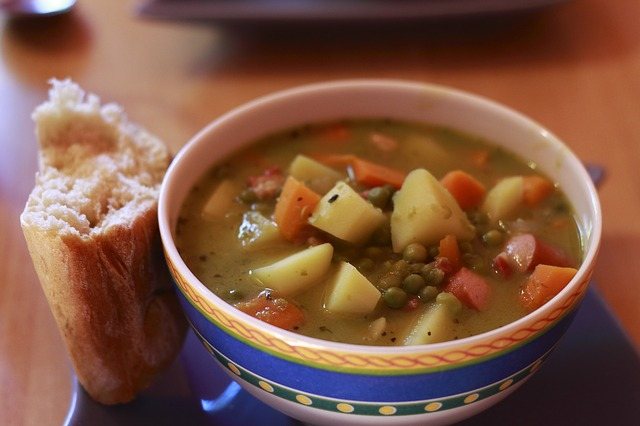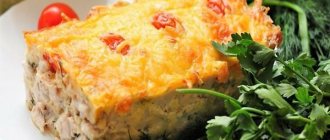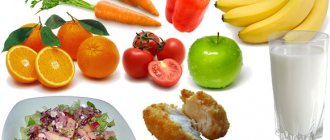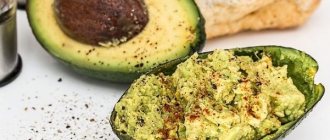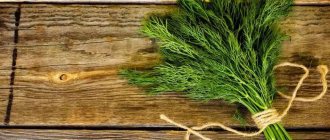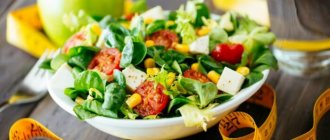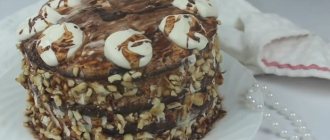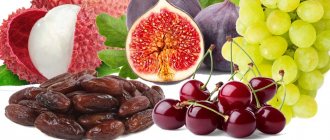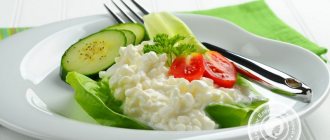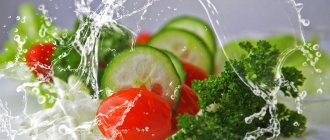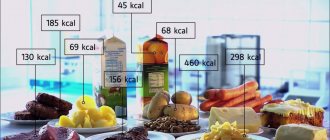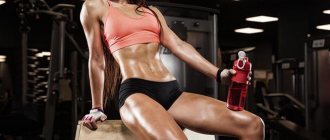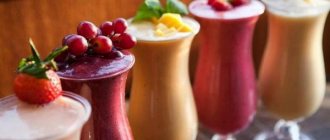General points
Indications
First, clearly define why you need a dietary lunch. For a person of normal weight, not predisposed to obesity, actively involved in sports, and leading a healthy lifestyle, this is hardly necessary. This choice should be made only by those who really need it.
Proper nutrition
A person who masters the basics of proper nutrition will never allow himself to overeat. He also clearly controls the consumption and intake of calories, so he is forced to ensure that lunch is low in calories. Although not as much as when losing weight, this indicator still limits it.
Low calorie diet
Low-calorie lunches automatically become low-calorie if you cut your daily calorie intake to lose weight. If you are overweight, you will have to figure out what you can eat during the day and what is strictly prohibited.
Therapeutic diet
Some treatment tables are characterized by a reduced daily calorie intake, so that lunch also automatically becomes low-calorie. The NKD category includes Pevzner diets No. 8, 8a, 8o, 9a, 10c.
Description
Diet lunch should be:
- 35-45% of daily calories;
- filling (to last until afternoon snack or dinner);
- tasty;
- energy (supply the body with energy for the rest of the day);
- varied (include complex carbohydrates, proteins, fiber, fats);
- balanced: BJU for proper nutrition - 25/50/25, for weight loss - 65/15/20.
How to determine calorie content
- Calculate the total daily calorie intake (formulas with examples).
- For three meals a day, calculate 45% of the resulting norm, for five meals a day - 35%.
- The upper limit for the average person with moderate physical activity should not exceed 900 kcal for 3 meals a day and 700 kcal for 5 meals a day.
- For those on a diet, it is recommended not to go below 540 kcal with 3 meals a day and 420 kcal with 5 meals. These are the minimum standards.
Only after mastering all these nuances can you begin to select products.
Products and dishes
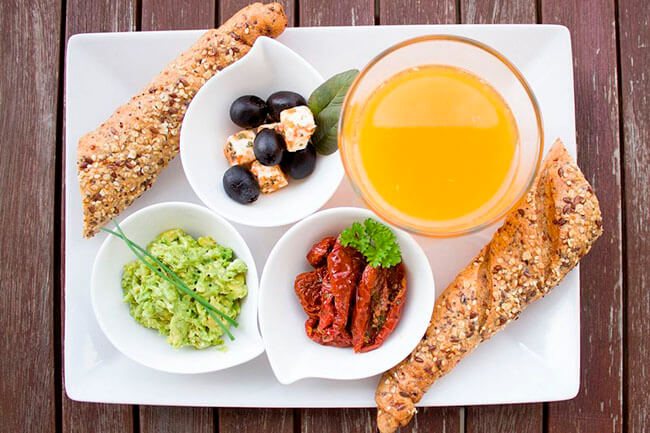
Lists
What you can cook:
- dietary soups (pureeed ones are especially good);
- side dishes from whole grain cereals, legumes or vegetables (stewed, baked, boiled, steamed);
- meat and fish dishes: cutlets, goulash, cabbage rolls, meatballs;
- vegetable salads.
The lowest calorie lunches come from the following foods:
- lean meat: chicken, turkey, beef, veal, rabbit;
- lean fish: asp, flounder, crucian carp, rudd, limonema, pollock, sea bream, sea bass, navaga, burbot, halibut, whiting, cod;
- whole grain cereals: brown rice, buckwheat, lentils;
- legumes: chickpeas, beans;
- mushrooms;
- any low-calorie vegetables.
Lunch from home
If you are not sure about the quality and calorie content of the dishes that you can order in the nearest cafe or canteen at work, you will have to take food to work with you from home. Otherwise, you won’t get a low-calorie lunch.
Helpful Tips:
- calculate the calorie content of lunch in advance and monitor the size of the portions that you put in a container or pour into a thermos - do not exceed the norm;
- it should not be perishable food or yesterday's dish;
- do not indulge yourself and do not put chocolate or candy in your purse - remember the calorie standards.
What exactly to take:
- hot soup - in a thermos;
- boiled meat or steamed fish along with a side dish (rice or buckwheat) - in the lunchbox;
- You can make cutlets and meatballs from meat or fish;
- low-calorie salad - in a plastic container;
- bread - just wrap it in a plastic bag;
- sauces - if you need them, buy them in stores in single-serve packages, but it’s better to prepare them at home and immediately pour them into your lunchbox with a side dish.
From the shop
If you had to buy an almost ready-made or semi-ready lunch from the store, we warn you right away: it will be extremely difficult. First, let's look at what you absolutely cannot buy.
Ready-made instant products (b/p)
The so-called "bapashki". Beautiful packages with big lunches, super soups, hot mugs, solyankas - all this is not only high in calories (about 450 kcal per 100 g), but also incredibly harmful to health (the gastrointestinal tract suffers).
Canned food
The name speaks for itself: for a long shelf life, manufacturers are forced to add preservatives to their composition, and lunch must be not only low-calorie, but also healthy. And they contain more oil than normal.
Smoked sausages, meat by-products
After smoking, products are saturated with dangerous carcinogens. Sausages, sausages, ham, ham, bacon, store-bought dumplings and cutlets contain substances such as sodium nitrite, polycyclic aromatic hydrocarbons, flavor enhancers, heterocyclic amines, trans fats. It has been scientifically proven that all of them, accumulating in the body, cause irreparable harm to it.
Fast food
This is the hardest thing - going to the store and not buying a hot dog, pizza, cheeseburger, or shawarma. It would seem both nutritious and simple: heat it up in the microwave and a hearty lunch is ready. However, we remember about trans fats and the number of calories. Moreover, the quality of their constituent products leaves much to be desired.
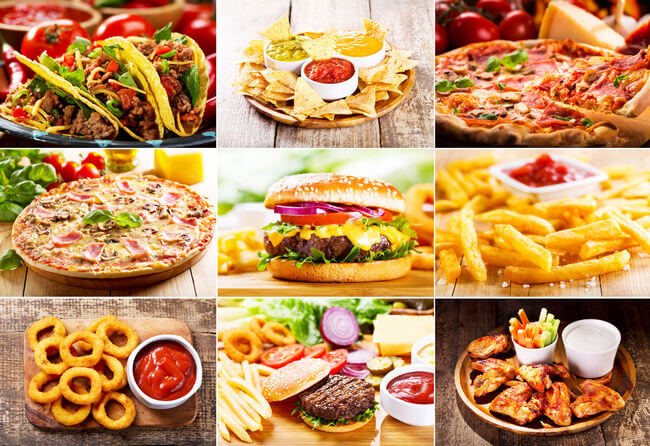
Say “no” to fast food, it is a “cholesterol bomb”, its consumption causes CVD and various gastrointestinal diseases
If you find yourself hostage to a situation and cannot organize a full meal, you will have a small choice in the store:
- the simplest vegetables from which you can cut a salad or eat them whole: tomatoes, cucumbers, carrots (fiber + complex carbohydrates);
- whole grain or regular rye bread (it will add energy value to lunch);
- a low-calorie bread spread that will add a piquant touch to your lunch;
- despite the fact that fruits are rarely included in the lunch menu, in such a situation there will be nothing else left, and since they are almost all low-calorie, you are not limited in choice;
- For tea you can buy low-calorie sweets: jam (Dieta Jam), preserves, jelly, special dietary desserts (Alpro Soya, Creme Brulee, Sambuc), bars (Herbalife, Turboslim), oatmeal cookies, biscuits or whole grain bread.
As a last resort, you can take canned red beans (99 kcal) or natural canned tuna (110 kcal). Of the canned foods, they are the least safe and lowest in calories.
From this set of products you can make a nutritious and tasty sandwich: a piece of rye bread - any low-calorie spread - a leaf of green lettuce - a slice of tomato - a thin slice of hard cheese - avocado puree (can be crushed by hand).
A lunch made from store-bought products will be low-calorie, but incomplete. Therefore, make sure that such situations occur as rarely as possible.
Proper lunch: what is it like?
Experts believe that a healthy lunch for weight loss should include all groups of nutritional components: proteins, fats (only healthy ones) and carbohydrates. Much depends on their proportion. In the afternoon, it is recommended to consume slow carbohydrates with proteins. This combination will help saturate the body with energy and better survive all the restrictions that weight loss involves.
But it is better not to eat foods that include sugar, that is, simple carbohydrates, for lunch. Surely you are familiar with the feeling of drowsiness and weakness after lunch. It is a consequence of a sharp jump in blood glucose. If you really want to add dessert to your lunch, use something healthy - dark chocolate, dried fruits, honey. It’s better to wait a little and then treat yourself to a delicious afternoon snack.
A proper lunch for weight loss should be about 350-450 kcal . If you don't plan to accurately count calories, you can determine your serving size using another method. The size of the protein dish should not exceed the size of your palm; add a couple of tablespoons of dry cereal and a large portion of vegetables - this will approximately be the required number of calories. Nutritionists define the ideal lunch for weight loss as a plate filled a quarter with porridge, a quarter with meat and half with vegetables. Lunch may also include a light vegetable soup. Remember that an excessive amount of even the healthiest food can be dangerous for your figure.
So, here is the menu , which can consist of a lunch for weight loss:
- Light vegetable soup or broth – 150-200 ml.
- 150-200 grams of meat or fish dish. It is better to stew, bake, boil, or steam meat and fish. If you are losing weight, it is better to avoid fried foods.
- From flour, choose rye or bran bread in quantities of no more than 30 grams.
- As a side dish, use stewed vegetables or salad, without using mayonnaise or sour cream. Quantity – 100-150 grams.
- You can drink a glass of freshly squeezed juice or compote without sugar, green tea or coffee.
When dining, don't rush. Chew your food slowly and thoroughly to help you feel fuller with less food. It is better to drink 30 minutes before lunch and an hour after. Avoid mixing food and liquid as it reduces the concentration of stomach acid, which slows digestion. After finishing lunch, sit quietly for at least ten minutes to allow your body to better absorb the nutrients.
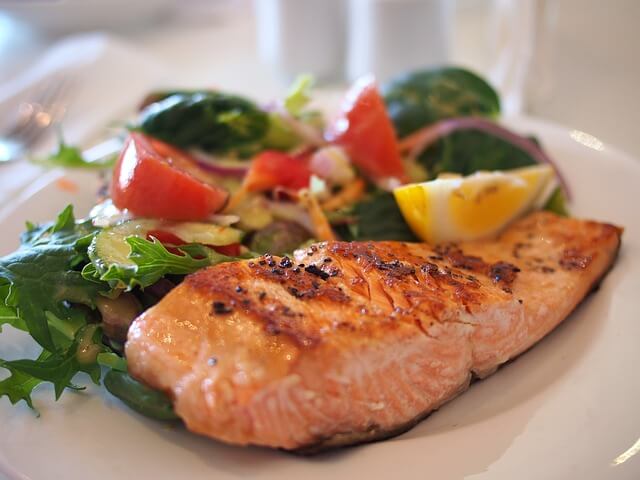
In many ways, the right diet lunch for weight loss will depend on what kind of diet you follow:
- On the Dukan diet you can eat any baked meat, fish and seafood; in the second and third phases you can also eat salad.
- On a minus 60 diet, sushi and rolls without cream cheese are allowed, almost any dish of fish, meat and poultry with the addition of cereals, soup without potatoes.
- On the Mediterranean diet, you can eat a piece of grilled fish (ideally it should be salmon and trout, but cod is also acceptable, just not fried), as well as any salad, plus a side dish of porridge.
- If you adhere to a protein diet , and you do not have time to have a full lunch, a protein lunch for weight loss can consist of a pack of cottage cheese, kefir or fermented baked milk and tea without sugar.
- If you need to stick to calorie counting , what to eat for lunch when losing weight can be anything from the list of healthy foods, it is only important to keep within the required number.
Recipes
We bring to your attention the lowest-calorie recipes for a complete, but at the same time dietary lunch. Calorie content is indicated per 100 g of already prepared dish. But remember that the serving size is not limited to this weight. A cup of soup is 200-250 ml, a plate of side dish is 150-200 g, so increase these figures by exactly as much as you eat.
Low-calorie lunch option #1
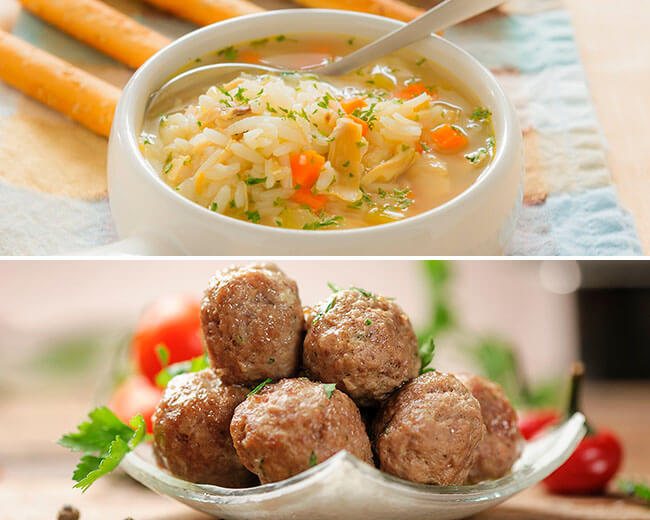
Perfect for taking with you to work.
First
Caña - Cuban soup with chicken and rice (91 kcal).
Rinse 100 g of brown rice thoroughly and boil until tender in 250 ml of water. Cut 800 g of chicken breast into small pieces and cook separately. Recook (with a minimum amount of oil) from 1 onion and 1 medium carrot. Blanch and puree 200 g of tomatoes. Cut 200 g of seeded bell peppers into large pieces. Chop some green onions. After the breast is almost ready, you need to leave just enough water in the pan to barely cover it. Add all the vegetables to it, simmer for 20 minutes. Before serving, add rice. Eat only hot.
Second
The main course for the second course is zucchini and turkey cutlets (87 kcal).
Mix 800 g of minced turkey breast with chopped onion. Grind 150 g of oatmeal in a blender. Grate 600 g of young zucchini. Squeeze out the juice and mix with the resulting oatmeal. Add spices to taste, chopped green onions, pepper and salt. If the mixture turns out too liquid, leave it in the refrigerator for an hour. Mix meat and vegetables, form into cutlets, place in a double boiler for 30 minutes.
What can I add?
- Side dish for the main course is boiled brown rice (110 kcal).
- To prevent lunch from seeming too bland, you can prepare a salad of tomatoes, cucumbers, green onions and olive oil (58 kcal).
- 1 piece of rye bread (30 g) will “weigh” about 65 kcal.
- For drinks, homemade tomato juice (42 kcal) or tea (0 kcal) with biscuits (18 kcal per piece) are recommended.
Low-calorie lunch option #2
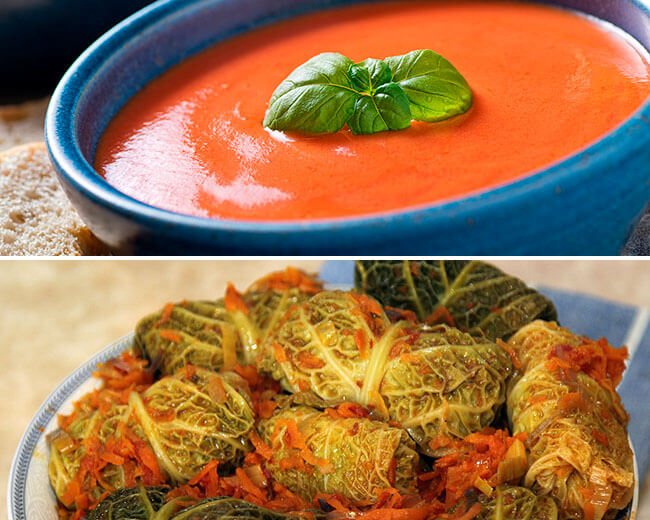
First
Tomato cream soup (107 kcal).
Blanch and puree 1 kg of fresh tomatoes. Boil 200 g of chicken breast, separate the meat from the bones, and turn into minced meat using a meat grinder. Mix vegetables with meat. Keep in a actively boiling steam bath for 10 minutes. Add spices to taste, chopped herbs, pepper, add salt, pour in 40 ml of olive oil. Cook for 5 minutes without a steam bath over low heat. To stir thoroughly. Pour into plates. Place a cube of mozzarella cheese in each.
Second
The main course for the second course is Savoy cabbage rolls (77 kcal).
Blanch the savoy cabbage leaves. If too hard, lightly boil in salted water. Mix 500 g of minced chicken with chopped onion, beaten egg and spices. Place the minced meat on cabbage leaves, roll them into envelopes, and place tightly on a baking tray. For the sauce, fry onions and carrots (50 g each), add 100 ml of tomato paste to them, heat for a couple of minutes, add 100 ml of 10% sour cream, spices, salt, bay leaf. Boil, reduce heat, simmer for 3 minutes. Pour the resulting mixture over the cabbage rolls. Bake in a preheated oven at 180°C for half an hour.
What can I add?
- Side dish for the main dish - boiled buckwheat (103 kcal).
- “Brush” salad in its classic version (cabbage, beets, carrots) with the addition of olive oil (60 kcal).
- 1 piece of rye bread (65 kcal).
- Homemade orange juice (36 kcal) or tea (0 kcal) with oatmeal cookies (90 kcal per 1 piece).
If you remove the chicken from the soup and make the stuffing in the cabbage rolls from rice and bell pepper, this option can fit perfectly into a vegetarian menu.
Low-calorie lunch option #3
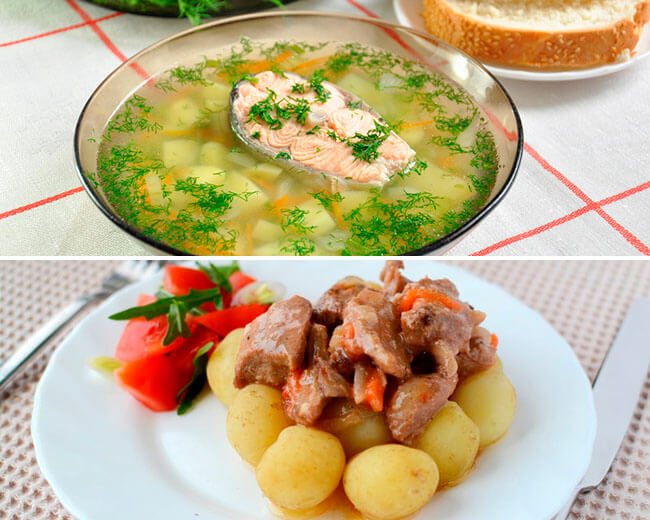
First
Fish soup in Finnish (59 kcal).
Cut 450 g of potatoes into cubes, add 1.5 liters of water and cook. Cut 400 g trout fillet into arbitrary pieces, add to potatoes. After half an hour, add fried onions and carrots (1 piece each), bay leaf, spices to taste, add salt. After 10 minutes, pour in 200 ml of 10% cream. After boiling, turn off immediately. Eat it hot.
Second
The main course for the second course is meat goulash (71 kcal).
Cut 400 g beef into small pieces. Lightly add salt. Fry in oil (there should be very little). Add onion half rings (100 g) and bell pepper cubes (150 g). Fry until golden brown. Add 5 g of paprika, add 50 ml of water, add 10 g of flour, mix thoroughly. Cut 900 g of new potatoes into the same cubes as the meat. Place on top of meat and vegetables. Close the lid. Simmer for 20 minutes.
What can I add?
- A side dish for the main dish in this version of lunch is not necessary, since the goulash is prepared with potatoes.
- Radish and herb salad with 10% sour cream (50 kcal).
- 1 piece of rye bread (65 kcal).
- Homemade cranberry juice (40 kcal) or tea (0 kcal) with dark chocolate (36 kcal in 1 slice).
This option will certainly satisfy men: fish as a protein food for sports, and hearty beef goulash to replenish the necessary energy.
What can you eat for lunch when losing weight: options
We looked at an approximate version of what you can eat for lunch while losing weight. And now we offer several specific menu variations that can be used every day.
- Option 1. Includes 200 ml of vegetable soup without potatoes, immediately or a minced chicken cutlet for the main course (100 grams), a couple of thin slices of rye or cereal bread, a salad with olives and cheese like Greek cheese (100 grams), and a glass citrus fresh juice. The juice should be diluted by half with water. Total volume – 200 ml.
- Option 2 . Another low-calorie lunch for weight loss might include 200 ml of chicken broth, 100 grams of chicken meat, a couple of rye toasts, 100 grams of fresh vegetable salad (you can use cucumber, tomato, bell pepper and vegetable oil with lemon juice as a dressing). You can supplement the menu with green or ginger tea.
- Option 3. Includes 200 ml of vegetable soup without meat, 100 grams of boiled poultry without skin and 100 grams of white cabbage salad. You can also eat up to 30 grams of rye bread and dried fruit compote.
- Option 4 . Another answer to the question of what to eat for lunch to lose weight is a fish first course, for example, 200 ml of fish soup, a piece of boiled fish from the broth, about 100 grams, 30 grams of bran, rye or cereal bread, 100 grams of beet salad and seaweed. You can also drink a glass of slightly salted tomato juice.
- Option 5. This variation allows you to eat a cold entrée for lunch while on a diet (beetroot soup, green borscht, okroshka without sausage and potatoes) in the amount of 200 ml, one chicken cutlet and 30 grams of rye bread or rye crackers. As a side dish, you can use stewed eggplant or zucchini, or fresh cucumber. You can complement the menu with fresh apple compote.
- Option 6. In this option, you need to eat vegetable soup, for example “Bonn” (it is better to use celery and tomatoes) in an amount of 200 ml. Also include 100 grams of boiled beans or pea porridge in the menu. They can be replaced with stewed mushrooms. You can have some rye bread and tea or coffee.
- Option 7 . For the first course - 200 ml of pea soup. On the second course - 100 grams of stuffed river fish. You can eat a couple of slices of rye bread, 100 grams of fresh salad and drink a cup of green tea.
These weight loss lunches can be alternated to keep the menu varied. They are designed for 350-400 kcal. Don't forget about healthy snacks too, they are important.
We recommend you find out: what to eat for dinner to lose weight?
